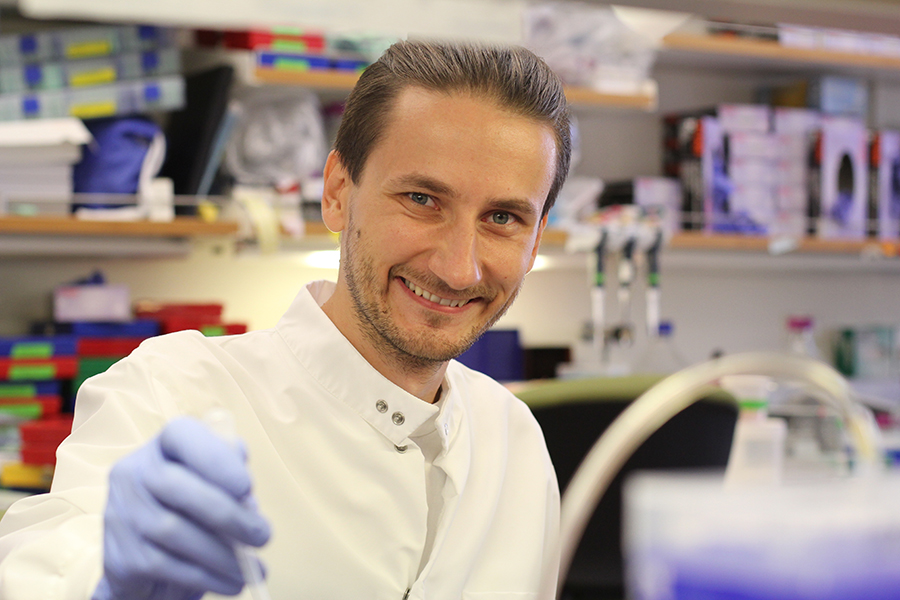
As a postdoctoral fellow in the Department of Stem Cell Biology and Regenerative Medicine at USC, Peter Fabian has proven himself to be a big fish in the pool of aspiring faculty members. Only three years after joining the USC Stem Cell laboratory of Gage Crump to study craniofacial development in tiny zebrafish embryos, Fabian has received a National Institutes of Health (NIH) Pathway to Independence Award. Known as the K99/R00, the award will help him transition from the postdoctoral to the faculty stage of his career.
Remarkably, in the past four years, two other postdoctoral fellows from the Crump Lab also received K99/R00s, and successfully transitioned to tenure-track assistant professorships: Lindsey Barske at Cincinnati Children’s Hospital, and Joanna Smeeton at Columbia University. Fabian is the third member of the Crump Lab to earn this prestigious award.
Tell me about your NIH fellowship project.
Stem cells reside in specialized microenvironments called “niches.” My project investigates a new population of cells that may function as a niche to support skeletal stem cells, allowing them to maintain and repair the vertebrate face. My work can provide new insights into how proper niche function ensures normal development and maintenance of the head skeleton, and how genetic mutations impair niche function and cause craniofacial birth defects in humans.
What inspired you to become a stem cell researcher?
I just love science. I did my studies as a biochemist, but my real passion for biology started at Charles University in Prague. Seeing how developing fish embryos change from hour to hour under the microscope is one of the most fascinating things I have experienced. When I’d show that to almost anybody, immediately, they’d start to ask how or why questions. I believe that by understanding the fundamental processes of developmental biology, we will be in a better position to control stem cells to help human patients.
How do you spend your free time?
I try to be with my family as much as possible, and then it doesn’t really matter where we are or what we are doing. Every day, I try to spend couple hours with my kids—currently, just in the parking lot near our apartment, biking or scooter-ing. If we can, we go camping or travel to Slovakia, where we are from.
What do you like most about living in Los Angeles and working at the Eli and Edythe Broad Center for Regenerative Medicine and Stem Cell Research at USC?
Possibilities in Los Angeles are really endless. I enjoy having the opportunity to relax with my family in nature or nearby parks. I live couple of miles from our campus, so I bike to lab. And what I like most about the Crump Lab are the people. It is a pleasure to work with them. I also appreciate the huge support from the USC’s stem cell research center.
What do you miss most about your native country of Slovakia?
Of course, our families and friends, whom we now miss even more. I also miss Slovak and Czech beer. And honestly, I would appreciate functional public transportation here in Los Angeles.
How did your previous postdoctoral fellowship—supported by the Hearst Foundations—contribute to your success?
Support from Hearst Foundations helped me at least twice. Immediately, it gave me confidence, and fully covered my salary and benefits. Second, professionally, it gave me the support to examine the craniofacial development of zebrafish on the single cell level, which led to the preliminary results for my K99 application.
What is the goal of your future career as a stem cell scientist?
I’m inspired by my mentor Gage Crump and my colleagues, as well as the environment here at USC. After my postdoc, I’d like to start my own lab and continue exploring the interactions of stem cells and their environment. I believe that the animal models that I am establishing as part of my postdoc training will be useful not only to me, but also to the broader scientific community.
How have you been spending your time outside of the laboratory during the COVID-19 remote work period?
The first couple weeks, I was one of essential personnel in the lab. I spent couple hours every day in our vivarium, feeding 25 thousand zebrafish. Then we worked on finishing a paper. However, I need to come back to lab to finish the last experiments. I’ve spent endless hours behind the computer on zoom meetings and analyzing single cell sequencing data. The most challenging has been to combine all this work effort with home schooling my children and getting used to the new “normal.”
Has the pandemic been a source of additional stress as you pursue an already competitive academic career?
On top of the pandemic, travel bans, and curfews, we are witnessing a huge, I believe, historical movement for equality. All of it is definitely adding uncertainty and stress, but also excitement and optimism. My wife Zuzana is helping me face these situations every day. She is very supportive. Without her, I wouldn’t be here.
